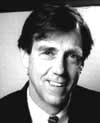|

|

|
VIEWPOINT:
Embracing
opportunities presented by facilities enhancement
By
Harrison Fraker Jr.
|
|
|
 Next
to complaints about parking, nothing can produce a wry smile
or invoke a "horror story" faster from faculty than their dealings
with physical facilities. Complaints about costs and how long
it takes to get things done are legion. Even our chancellor
has been known to tell tales about his experience with our facilities.
As a faculty member and dean who has come from outside the UC
system and who, as an architect and chairman of the campus Design
Review Committee, has watched the campus struggle with the challenges
of our physical facilities, let me offer the following observations. Next
to complaints about parking, nothing can produce a wry smile
or invoke a "horror story" faster from faculty than their dealings
with physical facilities. Complaints about costs and how long
it takes to get things done are legion. Even our chancellor
has been known to tell tales about his experience with our facilities.
As a faculty member and dean who has come from outside the UC
system and who, as an architect and chairman of the campus Design
Review Committee, has watched the campus struggle with the challenges
of our physical facilities, let me offer the following observations.
During past
budget-cutting cycles, the campus has maintained its excellence
by protecting the faculty at the expense of staff and facilities
- an understandable strategy - but one that has its costs. Too
often, the approach to facilities has been dominated by a perception
that they are a "free" commodity - provided by the state - a
nuisance that is tolerated in pursuit of the academic mission.
In this frame of mind, it is hard to imagine faculty perceiving
facilities as assets that must be cared for and enhanced. This
attitude puts our facilities at odds with the standards of excellence,
which we apply to the recruiting and retention of faculty and
students.
The seismic
safety needs of our buildings and infrastructure have brought
into sharp focus how much we have let our facilities slip in
terms of their deferred maintenance, but more fundamentally,
in how important they are to our academic teaching and research
missions.
Recognition
of the critical need to renew our facilities presents a tremendous
challenge, beyond the staggering costs, because it represents
institutional and cultural change. The chancellor has already
begun the process by creating a new position of vice chancellor
for capital projects (filled by Edward Denton); hired a new
campus architect, Langston Trigg; and both have begun the task
of reorganizing and revitalizing planning, design and construction
on campus.
While problems
still exist with some of the projects begun before these changes,
the signs of improvement are encouraging. A carefully developed
process for identifying, approving, budgeting, financing and
managing capital projects has been put in place. It promises
to bring budgets more carefully in line with the scope of projects.
It establishes clear milestones for approvals and accountability.
Most importantly, it will articulate all of the project costs
and benchmark them against the standards of the industry. In
addition, there are improved efforts to hire the best consultants,
planners, architects, engineers, and so on for each job. As
chairman of the Design Review Committee, I have seen marked
improvements in the organization, logic and quality of the projects
brought before our committee under this new regime.
But the campus
has only seen the beginning of what will probably be the largest,
most protracted and expensive facilities renewal effort in the
campus's history. For it to succeed, faculty attitudes will
have to change. Faculty will have to see facilities as a real
asset, essential to the core mission. The faculty will have
to be patient with the new process for capital projects and
yet demanding of it. Most importantly, the faculty will need
to engage the multiple efforts under way, from the facilities
master plan to the nitty-gritty seismic correction efforts,
through faculty Senate committees charged with identifying the
academic mission for facilities, to participating in individual
building committees and surge committees. For the campus to
succeed, the faculty, students and staff must have facilities
that match the standards of excellence we apply to our teaching
and research. This is going to take real commitment, participation
and change in the idea that facilities are somebody else's responsibility.
One hundred
years ago, Phoebe Hearst set a standard of excellence by sponsoring
an international competition for the plan of the Berkeley campus,
which attracted the vision and imagination of the world's best
architects of the time. While the challenges of a modern research
university are very different today, the standard of excellence
for our facilities should not change. As it was 100 years ago,
it is a matter of vision and imagination that the faculty must
bring to bear on the challenge.
Harrison
Fraker Jr., FAIA, is the William W. Wurster Professor and dean
of the College of Environmental Design.
Renewing
the Foundations of Excellence home
Source:
Berkeleyan
Special Issue, Fall 2000
|

|